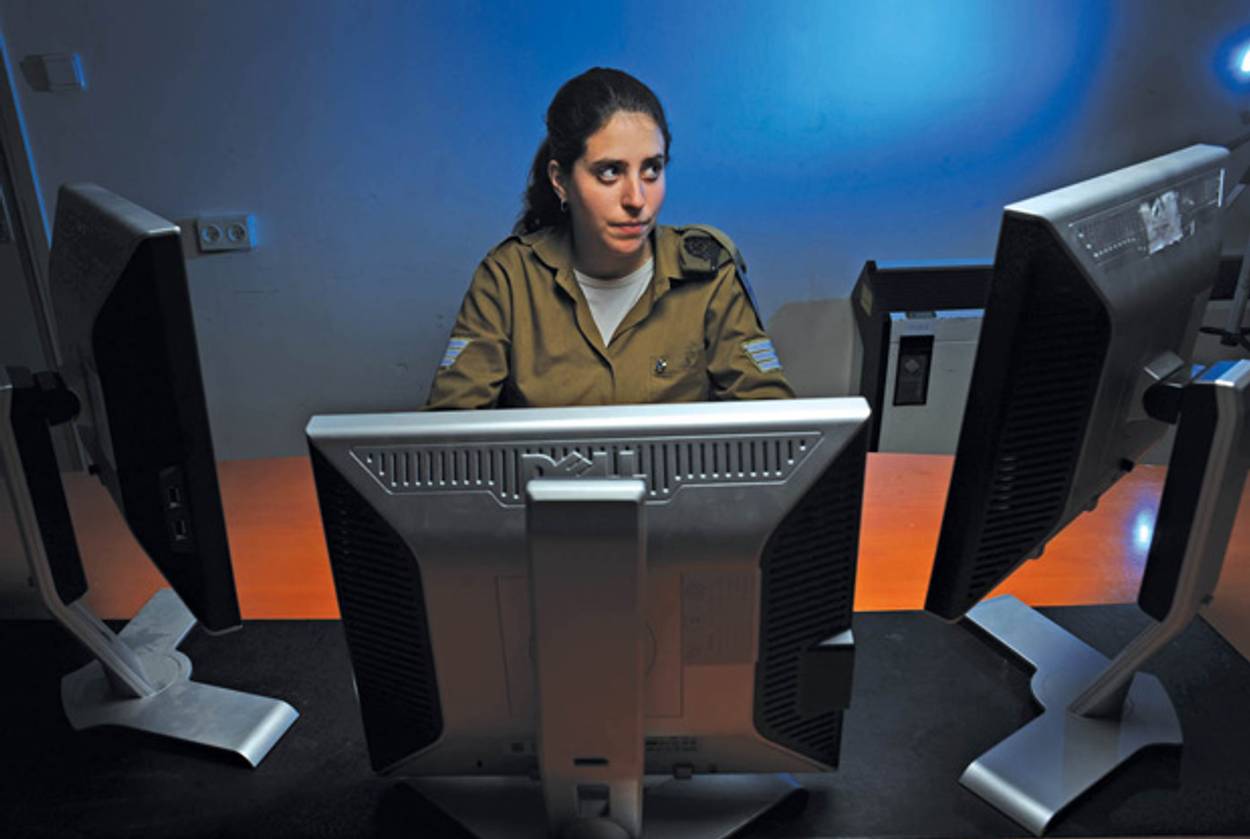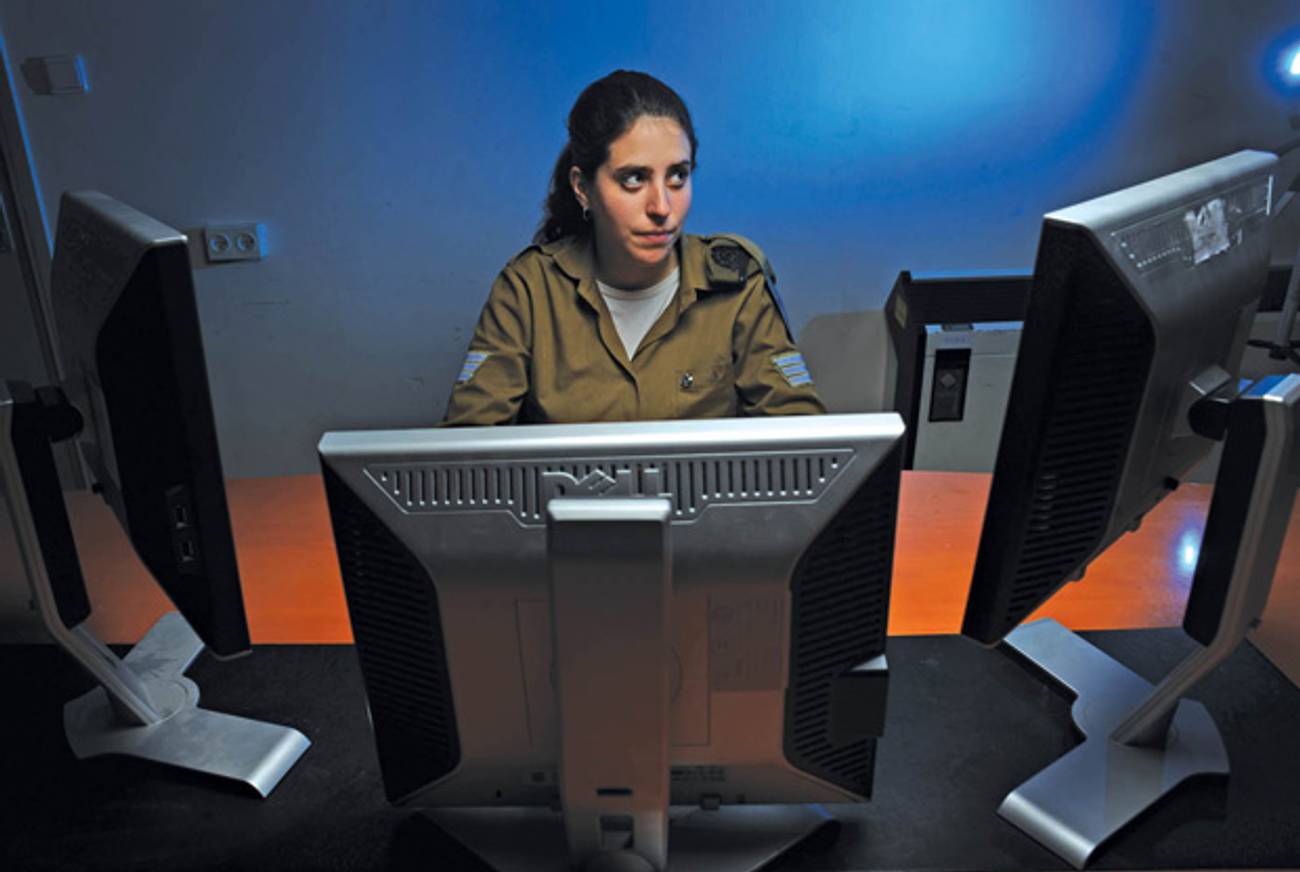The ‘Kids’ Behind IDF’s Media
Young Israeli soldiers have pushed older commanders into adopting a more aggressive social media strategy




After the first night of Israeli airstrikes in Gaza, now almost a week ago, a photograph began circulating around Twitter of a grinning 11-month-old who had been killed by an Israeli missile that landed on his house. Within hours, Avital Leibovich, an Israel Defense Forces spokeswoman, posted a reply of sorts: a photograph of another infant, this one an Israeli girl, wounded by a Hamas rocket in the southern town of Kiryat Malachi. It wasn’t the first skirmish of the virtual war being waged across social media networks by both the Israeli government and Hamas—the real-world hostilities were announced Nov. 14 by the IDF in a tweet trumpeting the death of Hamas leader Ahmed Jabari—but it was an early indication of how the awful life-and-death stakes of war have been reduced to Internet fodder.
The world is by now well aware of the power of social media to help foment and spread popular movements everywhere from Lower Manhattan to the streets of Cairo. But Operation Pillar of Defense may be the first war to feature direct trash-talking between enemies. “We recommend that no Hamas operatives, whether low level or senior leaders, show their faces above ground in the days ahead,” came a tweet from the official @IDFspokesperson account last Wednesday. “@IDFspokesperson Our blessed hands will reach your leaders wherever they are (You Opened Hell Gates on Yourselves),” came the reply from @AlQassamBrigade.
It’s not clear who’s running the Qassam Brigade’s twitter feed, but in Israel, the IDF’s social media operation is run by a 26-year-old immigrant from Belgium named Sacha Dratwa. In the past two years, Dratwa has taken a small operation initially created during Operation Cast Lead to streamline the IDF’s YouTube and Facebook presence and turned it into the most globally visible arm of the Israeli military. In the past year, the new media desk has rapidly expanded into new terrain, from commissioning content designed for viral sharing to creating a Foursquare-style game for the IDF blog that rewards frequent visitors to the site with badges. The IDF is also posting video of its drone strikes, starting with the Jabari assassination, as well as of Israelis taking cover during air raids and of Iron Dome units successfully thwarting rockets launched from Gaza.
“The government still has to generate the talking points, what we want to achieve, and then we turn it over to the kids, and they translate it into this new language of social media,” said Daniel Seaman, deputy director general of the Ministry of Public Information and Diaspora Affairs, who ran the government press office during Operation Cast Lead. “I say it’s magic.”
“We want to explain to people what happens in Israel, simply,” Dratwa said in a brief telephone interview late last week. “We believe people understand the language of Facebook, the language of Twitter.”
For Israel, taking the war to Twitter, Facebook, Instagram, and even Pinterest is a natural outgrowth of the Israeli government’s public diplomacy initiatives, from helping organize seminars to train Israelis to advocate on the country’s behalf over social media networks to underwriting a campaign to improve the image of settlers among bloggers.
The goal, as Dratwa explained it, is twofold: to get Israel’s narrative out in real time, as people read about red alerts in Tel Aviv and rocket landings in Gaza on Twitter, and to cut out the middleman of “old media” in communicating with pro-Israel activists. “What we try to do is to be fast and get information out before the old media,” Dratwa told me. “We believe people are getting information from social media platforms and we don’t want them to get it from other sources—we are the ones on the scene, and the old media are not on the scene as are the IDF.”
It’s not immediately clear what concrete impact the IDF’s Twitter battles are having on the course of public opinion. Foreign journalists have been allowed to enter Gaza during Operation Pillar of Defense—a change from Israeli policy during Operation Cast Lead, when foreign journalists were barred from Gaza—resulting in a steady stream of gripping footage and images from the territory. But the IDF boasts 185,150 Twitter followers viewing its stream of videos, photos, and updates, which includes information from the front and frequent reminders of Israel’s ongoing provision of food and medical services to Gazan civilians. “There’s an idea of playing to your base,” said Garth Jowett, a professor specializing in propaganda and media at the University of Houston. “But it’s very hard to change people’s minds with propaganda.”
The IDF’s new media presence was originally the brainchild of Aliza Landes (the American-born daughter of the historian Richard Landes), who was herself only 25 when, as an officer on the IDF’s North American press desk, she piloted the IDF’s first forays into virtual warfare during Operation Cast Lead in the winter of 2008-2009. “In Israel, Facebook had only just opened up, and it was considered a toy for kids,” Landes said. “YouTube was the same. They didn’t think of it as a dissemination tool that could be effective—it was just a way for people to waste time in the office.”
Landes had already written position papers trying to excite her commanders in the spokesman’s office about the possibilities of a more aggressive social media strategy, but it wasn’t until videos she posted on YouTube began to tally up impressive views that they paid attention. Originally, she told me late last week, she had used YouTube as a way to transfer video files to foreign journalists, who were prevented by the Israeli military from entering Gaza during Cast Lead and were in many instances forced to rely on IDF footage. “It wasn’t for public consumption,” Landes said. She soon began posting routine information updates, like statistics on the number of rockets fired, to an IDF blog and, by the time Cast Lead concluded in January, had moved to commissioning original videos from the military film department. “It was sort of my pet project on top of everything else I was supposed to be doing,” Landes said.
In August 2009, Landes succeeded in convincing her superiors to give her a dedicated budget for a new media operation. The first big test came in January 2010, not for a war but after the massive earthquake in Haiti, when Israel dispatched emergency medical staff to the Caribbean island. “People were sending us requests for assistance based on Twitter,” Landes said. “So, it wasn’t just a PR tool, it became a practical rescue tool too.” That summer, Landes was responsible for sending out footage from the controversial Mavi Marmara commando raid and convinced her superiors to give her near real-time access to video.
By the time Landes left later that year, she had a staff of 10 people devoted to putting out polished material in concert with other government ministries–some of which, particularly videos from the widely scrutinized Mavi Marmara episode, wound up giving ammunition to Israel’s critics. “It’s important to be in the conversation,” Landes said. “If you just say, ‘I’m going to cut this out entirely,’ you’re not doing yourself any favors, and in fact you’re doing yourself a disservice.”
And while the IDF’s social media campaign has drawn criticism from those who feel it trivializes war and its consequences, it’s unlikely to be the last of its kind. “We’re at a moment where this stuff is not only the way a lot of these communications happen, but the audience is primed for it,” said Sree Sreenivasan, a professor of social media at Columbia’s School of Journalism. “There’s no point saying they shouldn’t be doing it because no one is going to listen,” he said. “Both sides are going to do whatever is in their self-interest,” he added. “And social media is an example of that.”
***
Like this article? Sign up for our Daily Digest to get Tablet Magazine’s new content in your inbox each morning.
Allison Hoffman is a senior editor at Tablet Magazine. Her Twitter feed is @allisont_dc.
Allison Hoffman is a senior editor at Tablet Magazine. Her Twitter feed is @allisont_dc.